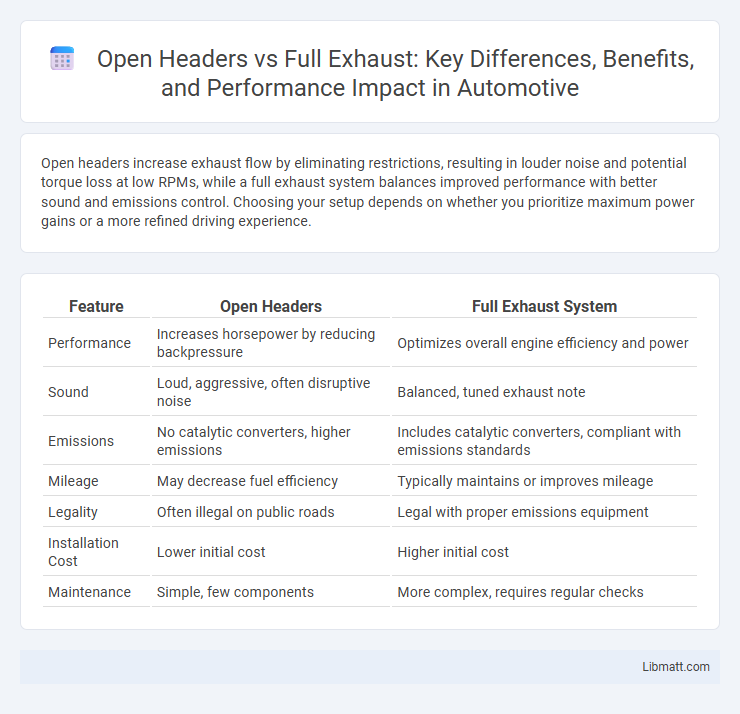Open headers increase exhaust flow by eliminating restrictions, resulting in louder noise and potential torque loss at low RPMs, while a full exhaust system balances improved performance with better sound and emissions control. Choosing your setup depends on whether you prioritize maximum power gains or a more refined driving experience.
Table of Comparison
| Feature | Open Headers | Full Exhaust System |
|---|---|---|
| Performance | Increases horsepower by reducing backpressure | Optimizes overall engine efficiency and power |
| Sound | Loud, aggressive, often disruptive noise | Balanced, tuned exhaust note |
| Emissions | No catalytic converters, higher emissions | Includes catalytic converters, compliant with emissions standards |
| Mileage | May decrease fuel efficiency | Typically maintains or improves mileage |
| Legality | Often illegal on public roads | Legal with proper emissions equipment |
| Installation Cost | Lower initial cost | Higher initial cost |
| Maintenance | Simple, few components | More complex, requires regular checks |
Introduction to Open Headers and Full Exhaust Systems
Open headers are exhaust manifolds without mufflers or catalytic converters, designed to maximize exhaust flow and increase engine power by reducing backpressure. Full exhaust systems include headers, mid-pipes, catalytic converters, resonators, and mufflers, offering balanced sound control alongside performance improvements. Compared to open headers, full exhaust systems provide enhanced drivability, emissions compliance, and noise reduction.
Understanding Exhaust System Components
Open headers improve engine performance by reducing backpressure and increasing exhaust scavenging, leading to enhanced horsepower and torque but often result in higher noise levels and less emission control. Full exhaust systems, including components like catalytic converters, mid-pipes, and mufflers, optimize exhaust flow while maintaining emission standards and reducing sound output. Understanding these components helps in selecting the right balance between performance gains and regulatory compliance for automotive exhaust setups.
What Are Open Headers?
Open headers are exhaust manifolds without mufflers or catalytic converters, designed to reduce backpressure and improve engine performance. They allow exhaust gases to exit directly from the engine cylinders, resulting in increased horsepower and a louder exhaust note. Commonly used in racing and high-performance vehicles, open headers prioritize maximum exhaust flow over noise reduction.
Defining Full Exhaust Systems
Full exhaust systems include all components from the engine's exhaust manifold to the tailpipe, designed to optimize exhaust flow and improve performance. Open headers, in contrast, refer to a type of exhaust manifold with exposed pipes that allow exhaust gases to exit more freely but without the complete system benefits like backpressure regulation and noise reduction. Your choice between open headers and a full exhaust system impacts engine efficiency, sound level, and emissions control.
Performance Differences: Open Headers vs Full Exhaust
Open headers increase exhaust flow by removing restrictions at the manifold, resulting in a noticeable boost in low-end torque and throttle response. Full exhaust systems optimize performance further by combining headers, high-flow catalytic converters (if applicable), and free-flowing mufflers, enhancing horsepower and improving overall engine efficiency. Your choice between open headers and a full exhaust depends on whether you prioritize raw torque gains or balanced power improvements and smoother sound control.
Sound and Noise Comparison
Open headers produce a louder, more aggressive exhaust note with minimal muffling, resulting in high-decibel, raw engine sound that emphasizes performance acoustics. Full exhaust systems incorporate mufflers and resonators, significantly reducing noise levels by dampening and smoothing sound waves for a balanced, quieter tone. Vehicle owners seeking maximum auditory impact prefer open headers, while those prioritizing noise control and compliance with regulations opt for full exhaust setups.
Impact on Engine Efficiency
Open headers increase engine efficiency by reducing backpressure, allowing exhaust gases to exit more freely and improving cylinder scavenging. Full exhaust systems optimize this effect by balancing backpressure and flow, enhancing torque and horsepower across a wider RPM range. Proper tuning of full exhaust setups maximizes combustion efficiency and power delivery compared to open headers alone.
Legal and Environmental Considerations
Open headers, which lack mufflers or catalytic converters, often violate noise regulations and emissions standards set by environmental agencies, making them illegal for street use in many regions. Full exhaust systems, equipped with properly calibrated components, ensure compliance with local laws by controlling noise levels and reducing harmful emissions such as carbon monoxide and nitrogen oxides. Understanding these legal and environmental considerations helps you maintain a street-legal vehicle while minimizing its environmental impact.
Suitability for Street vs Track Use
Open headers provide increased exhaust flow and improved horsepower, making them suitable for track use where maximum performance is essential. Full exhaust systems, including headers, catalytic converters, and mufflers, offer a balanced performance with noise reduction and emissions control, ideal for street driving. Your choice depends on whether you prioritize raw power for competition or legal compliance and comfort for everyday use.
Choosing the Right Exhaust Setup for Your Vehicle
Open headers enhance exhaust flow by reducing backpressure, leading to increased horsepower and a more aggressive sound, ideal for performance-focused vehicles. Full exhaust systems combine headers, pipes, and mufflers to optimize both power gains and noise control, providing a balanced setup for street and track use. You should evaluate your vehicle's purpose and local noise regulations to determine whether the raw power of open headers or the refined performance of a full exhaust best suits your driving needs.
open headers vs full exhaust Infographic

 libmatt.com
libmatt.com